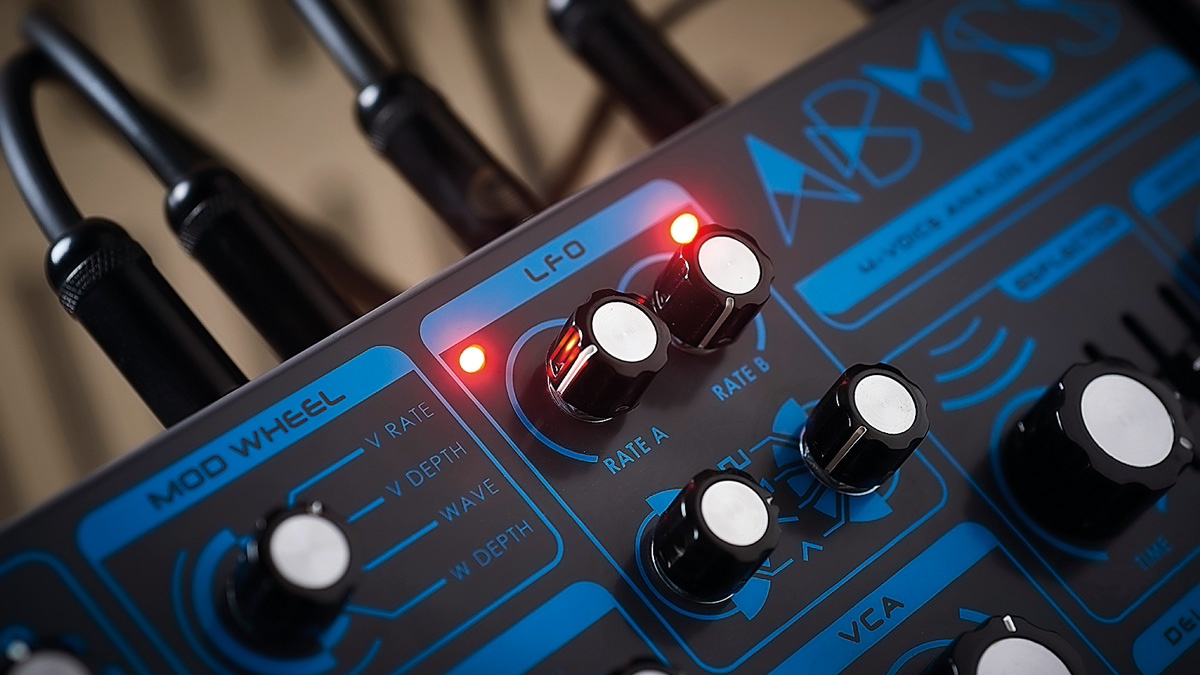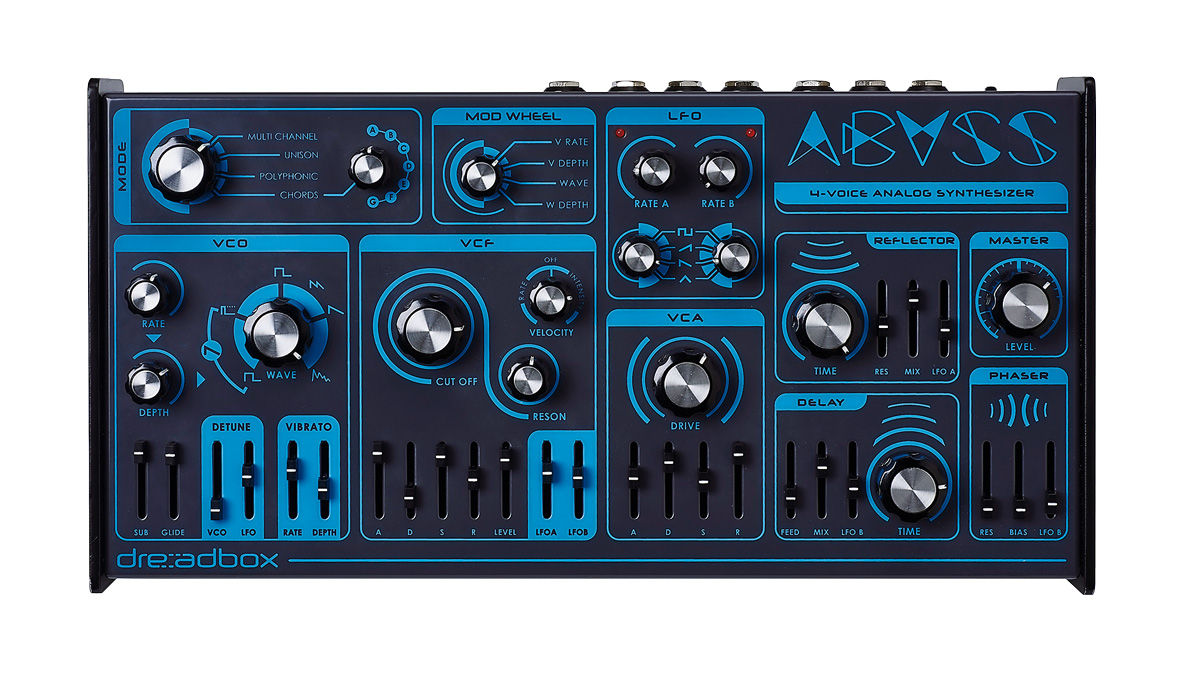MusicRadar Verdict
Despite lacking a few modern niceties, the Abyss is an excellent synth with analogue character by the bucketload.
Pros
- +
Excellent-sounding oscillators with powerful waveshaping tools.
- +
Unique, creative analogue effects.
- +
Multi-timbral and Chord modes are great additions.
Cons
- -
Slightly lacking in modern flexibility.
MusicRadar's got your back
Over the past few years, Athenian hardware brand Dreadbox has been steadily picking up fans with its line of effects, synths and modules. Now it is unleashing a new flagship synth, Abyss.
The Abyss is a four-voice analogue polysynth, loosely based around the sound engine of Dreadbox’s now-discontinued Murmux range. It comes in the form of a desktop module, built into a fixed-angled aluminium chassis a little over a foot in length.
There’s a simplicity to the unit’s build that’s revealing of Dreadbox’s small, independent operation, but what the synth lacks in design flourishes it makes up for in sheer ruggedness - the metal chassis feels like it could withstand a considerable beating without compromising the analogue innards.
The control panel is neatly and clearly laid out, offering direct control over almost every parameter via its sturdy rotaries and banks of sliders. The light-blue-on-dark-blue colour scheme isn’t particularly well suited to darker lighting conditions, but sensible interface design makes navigation of the synth feel intuitive.
Each synth voice features a single VCO supplemented by a square wave sub oscillator. The VCO wave shape is controlled using a continuous rotary, which can morph the source sound from a square wave through to square-saw, pulse and saw shapes, then finally into noise mode.
There’s a dedicated LFO for this waveshaper too, with rate and depth controls. The four-synth voices can function in a variety of modes. In Multi Channel mode, the four voices are controlled via separate MIDI channels. In Unison mode, the voices create a single thick, detuned stack, whilst Poly mode offers standard four-voice polyphony, controlled via a single MIDI channel.

Finally, Chord mode uses a single note to trigger a selection of pre-defined four-note chords. There are six preset chords shapes and a user-defined mode, which stores the last four notes played in Poly mode.
It’s worth noting that - via a back panel switch - the Abyss can be set to function in multi-timbral mode, in which the Chord selector is used to select and edit each voice’s envelopes individually. All of which ups the sonic flexibility.
Beyond the oscillator section, each synth voice features a 24dB low pass filter, with resonance capable of being pushed into self oscillation. The filter has its own digital ADSR envelope with depth control. There’s also a velocity dial that can be used to send incoming velocity messages to control either the speed of the filter envelope’s attack or the overall depth of the envelope’s effect.
Beyond this is an amp section with another digital ADSR envelope. Much of the Abyss’s unique character comes courtesy of its onboard analogue effects. The first of these is a Drive circuit attached to the amp section. Dialling this in will add extra body to sounds, and while it stops short of providing full-blown distortion, it’s capable of some very pleasing mid-focused saturation.
Beyond this is the Reflector, which is a short bucket-brigade delay with a maximum time of 50ms. For control here we get a Time rotary accompanied by feedback and mix controls, designed for creating chorus, flange and tape-like fluttering effects.
...for a classically minded analogue synth waiting to be learnt, experimented with and discovered, the Abyss could be an inspirational and reinvigorating purchase
Next is a more traditional delay, with a time range from 40ms up to 200ms. Again, this features a prominent Time dial along with sliders controlling feedback and wet/dry level.
Finally, Abyss features a four-stage OTA phaser with feedback control - effectively also functioning as a wet/dry mix - along with bias, for controlling initial phase offset.
The Abyss also features two global LFOs, with sliders dotted around its interface to dial in modulation for parameters including oscillator detune, filter cutoff and each of the three delay-based effects. Each can be set to one of four wave shapes and has its own rate control.
Finally, a Mod Wheel selector allows a MIDI modulation input to be assigned to vibrato rate or depth, wave shape, or the depth of the waveshaper LFO.
Compared to similar, recent analogue polysynths, the Abyss is resolutely old-school in its approach. There’s nothing in the way of presets, patch memory or direct USB-powered DAW integration. Instead control is handled via a MIDI input (which is joined by a MIDI thru port) along with CV/expression inputs for filter cutoff, along with the Reflector, Delay and Phaser modulation.
There’s not a lot in the way of MIDI CC control either - other than sustain, portamento switch and all notes off - meaning there’s no chance of setting up your own software editor or DAW automation. There’s no tempo sync for the delay effects either, meaning these always need to be configured by ear. As a result of this, the Abyss is perhaps not going to suit those looking for a ‘workhorse’ polysynth.
Saying that, it does offer more flexibility than initially meets the eye, thanks in part to its multitimbral capabilities, but also due to the addition of a rear-panel audio input that allows external signals to be processed via its effects. There’s a separate dry output for the synth too, for bypassing the effects section.
The Abyss’s oscillator section features per-voice glide and vibrato controls, plus a detune control for offsetting the four voices, all of which is great for thickening up the sound. The vibrato can be controlled via a MIDI mod wheel input, which is a nice touch, particularly for more performance-minded users. The detune can be modulated by an LFO, which is great for creating exaggerated pitch modulations that suit vintage-style chords and drones. Of course, when it comes to analogue synths, not all detune and pitch drift is intentional and welcomed. Dreadbox has stated that the biggest challenge in creating their first polysynth was finding a method to overcome tuning issues involved in combining multiple synth voices. Their solution was to fit the Abyss with an auto-tune capability, allowing users to easily re-tune the oscillators themselves. While the oscillators seem pretty stable anyway - at least during our time spent with the synth - this is a neat and simple solution should you notice any wayward drift. A flip of a back panel switch can also repurpose the Waveshaping knob as a fine-tune control, should you require deeper control over oscillator pitch.
What the Abyss lacks in modern flexibility, it more than makes up for in character. There’s real quality to the raw sound of the oscillators. The continuous waveshaping capability is really excellent too; holding down a chord and morphing between shapes can generate gorgeous, detailed sonic textures, particularly once the dedicated LFO is brought into play.
Coupled with the detune and vibrato [see Turn On, Tune Up], it lends the Abyss bucketloads of character even before the filter or effects have been brought into play. The four-pole filter sounds stellar too.
From a flexibility perspective, it would be nice to have a few more filter mode options than just a single 24db LPF, but the included filter suits the sound of the Abyss very well - it’s capable of punchy basses with the cutoff rolled down, and significantly changes the tonal quality of the oscillators with a little resonance added.
The effects are the real highlight of the Abyss though. Again, these are rather esoteric and offer unique character rather than do-it-all flexibility. However, they work fantastically with the synth engine, and each other. They’re the sort of processors it’s probably best to approach from an experimental angle - you could easily lose hours slowly tweaking the time settings of the three delay-based effects and listening to the often unpredictable results.
In the time spent with the Abyss for this review, we happened upon everything from LFO-driven, pitch-spiralling delays to weird static phasers and much more besides. Having the ability to process audio through these via the external input is almost worth the price of entry even disregarding the synth itself. This is pretty well sums up the Abyss.
Depending on how you look at it, you could argue that it offers slightly poor value for money compared to its analogue poly contemporaries: Korg’s similarly four-voiced Minilogue offers more flexibility at just over half the price, and Behringer’s similarly-priced Deepmind has three times the voice count, plus a host of modern bells and whistles.
There’s a definite case to be made, however, that neither of those instruments are as inspirational and characterful as the Abyss. If you’re after a ‘do-it-all’ analogue poly to cover all your studio needs, it’s probably worth looking elsewhere. But for a classically minded analogue synth waiting to be learnt, experimented with and discovered, the Abyss could be an inspirational and reinvigorating purchase.
I'm the Managing Editor of Music Technology at MusicRadar and former Editor-in-Chief of Future Music, Computer Music and Electronic Musician. I've been messing around with music tech in various forms for over two decades. I've also spent the last 10 years forgetting how to play guitar. Find me in the chillout room at raves complaining that it's past my bedtime.
"That's what it takes to make music that's gonna last forever": Olivia Rodrigo and Chappell Roan producer Daniel Nigro on crafting timeless tracks
“A fully playable electro-mechanical synth voice that tracks the pitch of your playing in real time”: Gamechanger Audio unveils the Motor Pedal – a real synth pedal with a “multi-modal gas pedal”
“It was the first rock monster that we'd created”: How an explosive 2001 switch-up revealed just how ferocious Muse could get










